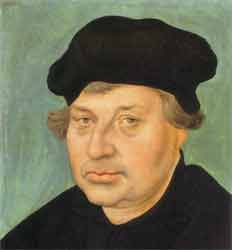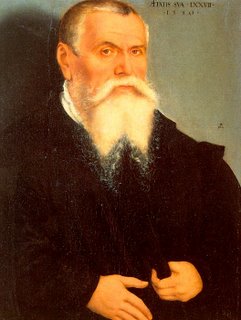The Big Blogroll O'Vark grows by two with the addition of one new blogger and one who's been around since last September but whose writing I've just recently discovered. The self-styled Black Knight writes A Lutheran Teen Blog and while he has just four posts, he shows definite potential. Besides the possible avocational pitfall of long-term blogging burnout, I wonder if he'll keep the name and URL as he ages or if we'll have to change our bookmarks to stay up with A Lutheran Twenty-Something Blog, A Lutheran Thirty-Something Blog, and the like.
Our longer established inductee is Des Moines Girl, author of Des Moines 360. This blunt-speaking Drake University grad is well-equipped to expound upon everything from stupid Americans to naked guys in chimneys, as well as all manner of other non-related subjects. Any blog that includes a favorite quote from one of my favorite authors (Mark Twain) will entice me to return: "Suppose you were an idiot and suppose you were a member of Congress. But I repeat myself."
 Usually, when I'm bored but feel like posting, I can find an idea either in the news or at Wikipedia's Days category. I just read through the list of commemorations and celebrations until I find one that interests me and begin writing. Actually, I usually need to decide among several possible topics and narrow it to one.
Usually, when I'm bored but feel like posting, I can find an idea either in the news or at Wikipedia's Days category. I just read through the list of commemorations and celebrations until I find one that interests me and begin writing. Actually, I usually need to decide among several possible topics and narrow it to one.As a blogger, I thought this one showed promise. Intellectual property discussions have been part and parcel of the development of civilization. They usually boil down to issues of pride, power, and pocketbook — often all of these are involved in some way. How can I make a buck on this idea? How will I be honored for these thoughts? Who can I control if I implement this? Such thoughts are fodder for lawyers and for those who develop intellectual properties.
 World Intellectual Property Day is an effort by the World Intellectual Property Organization (WIPO) to educate people concerning all areas of intellectual property, to help establish and maintain rights, and to serve as an international clearinghouse for related information, laws, treaties, and the like. It includes a link to a poster and these cool bookmarks shown here.
World Intellectual Property Day is an effort by the World Intellectual Property Organization (WIPO) to educate people concerning all areas of intellectual property, to help establish and maintain rights, and to serve as an international clearinghouse for related information, laws, treaties, and the like. It includes a link to a poster and these cool bookmarks shown here.For sake of discussion, WIPO provides a short, clear definition: "Intellectual property refers to creations of the mind: inventions, literary and artistic works, and symbols, names, images, and designs used in commerce." It goes on to divide such properties into Industrial and Copyright categories and provides links for further definition and understanding.
What all this means in the real world is that if you steal from my pages or use my ideas for your gain, you're going to get a royal snout-slapping.
Here's a big Aardvark welcome to the two newest enrollees in the Great Big Blogroll O' Vark. Say howdy to Living Like a Lutheran, who made big splash in the confessional Lutheran blogosphere with an entry in the new Lutheran Carnival and The Tarheel Lutheran, whom I cherry-picked from Maria at Musical Ramblings.
Two changes also occurred. Lutheran Jargon is now Soldiers of the Cross, although the LJ moniker will remain for his upcoming podcasts. Different blogs have this other one listed variously as the Urukite, Operation Iraqui Freedom, or other things. The most important thing now is that he's home from Iraq and involved in Life at Seminary. Feel free to swing by and leave him a "welcome home" comment.
Remember: Anyone who'd like the confessional Lutheran list, the whole blogroll, or all the sidebar links may have it for the asking.
Blog long and prosper.
 The book of Acts mentions a Mark, or John Mark, later called a kinsman of Barnabas (Colossians 4:10). The house of his mother Mary was a meeting place for Christians in Jerusalem (Acts 12:12). When Paul and Barnabas, who had been in Antioch, came to Jerusalem, they brought Mark back to Antioch with them (12:25), and he accompanied them on their first missionary journey (13:5), but left them prematurely and returned to Jerusalem (13:13).
The book of Acts mentions a Mark, or John Mark, later called a kinsman of Barnabas (Colossians 4:10). The house of his mother Mary was a meeting place for Christians in Jerusalem (Acts 12:12). When Paul and Barnabas, who had been in Antioch, came to Jerusalem, they brought Mark back to Antioch with them (12:25), and he accompanied them on their first missionary journey (13:5), but left them prematurely and returned to Jerusalem (13:13).When Paul and Barnabas were about to set out on a second missionary journey, Barnabas proposed to take Mark, but Paul thought him unreliable, so that eventually Barnabas made one journey taking Mark, and Paul another journey taking Silas (15:36-40). Mark is not mentioned again in Acts. However, it appears that he became more reliable, for Paul mentions him as a trusted assistant in Colossians 4:10 and again in 2 Timothy 4:11.
The Apostle Peter had a co-worker whom he refers to as "my son Mark" (1 Peter 5:13). Papias, an early second century writer, in describing the origins of the Gospels, tells us that Mark was the "interpreter" of Peter, and that he wrote down ("but not in order") the stories that he had heard Peter tell in his preaching about the life and teachings of Jesus. Debate continues as to the veracity of some of Papias' records, but this one is considered genuine by many scholars.
The Gospel of Mark, in describing the arrest of Jesus (14:43-52), speaks of a young man who followed the arresting party, wearing only a linen cloth wrapped around his body, whom the arresting party tried to seize, but who left the cloth in their hands and fled naked. Many think that this young man was the writer himself, since the detail is hardly worth mentioning if he were not.
Tradition holds that after Peter's death, Mark left Rome and went to preach in Alexandria, Egypt, where he was eventually martyred.
It is natural to identify the John Mark of Acts with the Gospel-writer and interpreter of Peter, and this identification is standard in liturgical references to Mark. However, "Mark" is the commonest of Latin first names, and they may well have been separate people.
Mark's symbol in Christian art is a often a lion, usually winged. In Revelation 4 and throughout much of his vision, John sees about the throne of God four winged creatures — a lion, an ox, a man, and an eagle. (Compare with the beings in Ezekiel 1 and 10.) Custom supposes that these represent the four Gospels or the four Evangelists (Gospel-writers).
One way to match the creatures with the Evangelists is to say that the man stands for Matthew, whose narrative begins with the human genealogy of Jesus and who often quotes Christ speaking of Himself as "the Son of Man"; the lion stands for Mark, whose narrative begins with John the Baptist crying out in the desert (a lion roars in the desert); the ox, a sacrificial animal, stands for Luke, whose narrative begins in the Temple; the eagle, then, stands for John, whose narrative begins in Heaven, with the eternal Word and who writes in a lofty style.
Lection
Psalm 146
Isaiah 52:7-10
2 Timothy 4:6-11, 18
Mark 1:1-15
Collect
O almighty God, as You have enriched Your Church with the precious Gospel proclaimed by the Evangelist Saint Mark, grant us firmly to believe Your glad tidings of salvation and daily walk according to Your Word; through Jesus Christ, Your Son, our Lord, who lives and reigns with You and the Holy Spirit, one God, now and forever.
Johann Walter (also Johannes Walther) was born in 1496 and began serving at the age of 21 as a composer and bass singer in the court chapel of Frederick the Wise. In 1524, he published a collection of hymns arranged according to the church year. It was well received and served as the model for numerous subsequent hymnals.
In addition to serving for 30 years as kantor (church musician) in the cities of Torgau and Dresden, he also assisted Martin Luther in the preparation of the Deutsche Messe of 1526, a setting of the Liturgy to hymns in the German language.
Walter is remembered as the first Lutheran kantor and composer of church music. Among his most cherished works is Der Bräut'gam wird bald rufen (The Bridegroom Soon Will Call Us). The Choral Wiki has several Walther pieces and some .WAV files are at the Johann Walter Gymnasium, Torgau site.
Art by Picasso, Rubens, and Cranach ... Latin words ... Victor Hugo and Joseph Heller references ... pictures of Pastor Snyder's "unknown Lutheran" ... plenty of links to good Lutheran writing, including a newly-discovered confessional blogger. Yep, Like Newborn Carnivals, we arise to await the bestowal of God's gifts.
The bells, the bells....
After considering waiting for a longer track record, Brother Martin's posts from today convinced me to list Luther at the Movies immediately. No, I wasn't swayed by his citation of yours truly nor by John 13-27's agreement with me. He's just too funny — and too Lutheran — to resist.
I'm waiting to see if this one keeps posting. If he does, then this new blog will soon be in my blogroll and a favorite regular read. His reviews are clear and blunt and his profile's a hoot.
Who is he? He's "Luther, You Idiot!" and he's your host for Luther at the Movies.
He says of himself, "Join me, Doctor Martin Luther, as I do to contemporary cinema what I did to the medieval whore of Babylon. Unless I am convinced that a moving picture does not emit a stench to choke a sow, my conscience is captive to my impeccable taste. Here I sit, in a comfy Loews stadium-seating theatre, replete with Nacho bar and adjustable arm rests! I can do no other!"
Tonight's the deadline for the next Lutheran Carnival, so get those entries in so Pastor Snyder can assemble LC XXII.
 Known as the father of medieval Scholasticism, Anselm was born in Italy in 1033. Most closely associated with England, he first served as prior and abbot of the Benedictine Abbey in Bec, Normandy, later becoming Archbishop of Canterbury for many years. A brilliant scholar and writer who loved the works and followed in the way of Augustine, Anselm used his political skills with the British kings on behalf of the established Christian Church, affirming that it is the leadership of the Church and not the state which has the responsibility of establishing structure and maintaining order among the clergy.
Known as the father of medieval Scholasticism, Anselm was born in Italy in 1033. Most closely associated with England, he first served as prior and abbot of the Benedictine Abbey in Bec, Normandy, later becoming Archbishop of Canterbury for many years. A brilliant scholar and writer who loved the works and followed in the way of Augustine, Anselm used his political skills with the British kings on behalf of the established Christian Church, affirming that it is the leadership of the Church and not the state which has the responsibility of establishing structure and maintaining order among the clergy.Anselm's book Cur Deus homo (Why God Became Man) expresses his thoughts on Christ's atonement and taught that the reason for the incarnation was that Jesus, the Son of God, would suffer and die in place of sinners. His Monologium shows his development of an ontological argument for the existence of God.
He was canonized in 1494 by Pope Alexander VI.
More at the Christian Cyclopedia, Wikipedia, and James Kiefer's Hagiographies.
Lection
Psalm 139:1-9 or 37:3-6,32-33
Romans 5:1-11
Matthew 11:25-30
Collect
Almighty God, who raised up Your servant Anselm to teach the Church of his day to understand its faith in Your eternal Being, perfect justice, and saving mercy, provide Your Church in every age with devout and learned scholars and teachers, that we may be able to give a reason for the hope that is in us; through Jesus Christ our Lord, who lives and reigns with You and the Holy Spirit, one God, now and forever.
Technorati Tags: Saint Anselm of Canterbury | Archbishop of Canterbury | Scholasticism | ontological argument | atonement
 Johannes Bugenhagen (1485-1558), from Pomerania in northern Germany. Because of his ancestral region, he took the Latin name Pomeranus and Luther often called him "Doctor Pommer."
Johannes Bugenhagen (1485-1558), from Pomerania in northern Germany. Because of his ancestral region, he took the Latin name Pomeranus and Luther often called him "Doctor Pommer."He was appointed pastor of Wittenberg in 1523 through the efforts of Martin Luther and thus served as Luther's own pastor and confessor. One of the greatest scholars of the Reformation era, he helped translate the New Testament into Low German and wrote a commentary on the Psalms. He also worked to organize the Lutheran Church in northern Germany and Denmark, journeying to Copenhagen where he crowned both King and Queen and consecrated seven men to the offices of superintendent and bishop.
For those who think that their pastors preach too long, you share that complaint with Luther, who described Pomeranus' preaching as "whatever comes to mind," much like a maidservant chatting with another at the market. One story says that Luther recommended Bugenhagen cut his sermons in half and preach no more than an hour, lest all minds wander.
More information is available through the Christian Cyclopedia and Wikipedia.
Lection
Psalm 46
Isaiah 55:6-11
Romans 10:5-17
John 15:1-11
Collect
O Lord God, heavenly Father, who called Johannes Bugenhagen as pastor and confessor of the Faith, grant us faithful pastors in our time; pour our Your Holy Spirit on Your faithful people, keep them steadfast in Your grace and truth, protect and comfort them in all temptation, defend them against all enemies of Your Word, and bestow on Christ's Church Militant Your saving peace; through Jesus Christ, Your Son, our Lord, who lives and reigns with You and the Holy Spirit, one God, now and forever.
Technorati Tags: Bugenhagen | Docter Pommer | Pomeranus | Reformation
The blogroll grows by two with the addition of Latif's Memoir and Sew Liturgical.
Remember that, as I noted in Building a Lutheran Presence; Part 2, our blogrolls help each other find new readers and improve search engine rankings. If you'd like the full list of sidebar links, the Lutheran blogs and other resources, or the confessional blogroll only, please email me and ask.
This Aardvark highly recommends Paul McCain's "You Are Not Free to Use This Liberty" — Thoughts on Liturgical Uniformity. Thanks also for the addition of a blogroll to his Cyberbrethren site.
"On the seventh day God finished his work that he had done, and he rested on the seventh day from all his work that he had done. (Genesis 2:2 ESV)"

Pastor Snyder comments today on Christ's Sabbath in the tomb as He moved from His state of humiliation into His eternal exaltation at the right hand of the Father.
The Holy Gospel
"When it was evening, there came a rich man from Arimathea, named Joseph, who also was a disciple of Jesus. He went to Pilate and asked for the body of Jesus. Then Pilate ordered it to be given to him. And Joseph took the body and wrapped it in a clean linen shroud and laid it in his own new tomb, which he had cut in the rock. And he rolled a great stone to the entrance of the tomb and went away. Mary Magdalene and the other Mary were there, sitting opposite the tomb.
"Next day, that is, after the day of Preparation, the chief priests and the Pharisees gathered before Pilate and said, 'Sir, we remember how that impostor said, while he was still alive, "After three days I will rise." Therefore order the tomb to be made secure until the third day, lest his disciples go and steal him away and tell the people, "He has risen from the dead," and the last fraud will be worse than the first.' Pilate said to them, 'You have a guard of soldiers. Go, make it as secure as you can.' So they went and made the tomb secure by sealing the stone and setting a guard. (Matthew 27:57-66 ESV)"
Collect
Abide with us, Lord, for it is toward evening, and the day is far spent. Abide with us and with Your whole Church. Abide with us in the end of the day, in the end of our life, in the end of the world. Abide with us with Your strength and blessing. Abide with us when the night of affliction and temptation comes upon us, the night of fear and despair when death shall come. Abide with us and with all the faithful through time and eternity.
Have a favorite rendition of the Luther Rose? If so, the Old School Confessional uses a tongue-in-cheek post entitled Shema in 2006? to solicit art work for his newest tattoo. I'm gonna have to dig through my files to see if I can find something appropriate.
I do hope that he also gets some photos of his existing body art posted for all of us to view.
Confessional Lutheranism's Q & A guy, the Rev. Walter Snyder of Ask the Pastor, asks for other bloggers to help fill Lutheran Carnival XXII to the brim. See A Carnival "Call for Papers" for the coming edition's ground rules and remember that you don't have to wait until 10 minutes before the deadline (even if I usually do).
And as he reminds his readers, if you haven't yet seen Carnival XXI, it's up at Necessary Roughness.
Call it nepotism; call it national pride — at any rate, Pastor Klages of A Beggar at the Table clued me in on three of his kinfolk, who also happen to be confessional Lutherans and Canadians. These three all seem to fit under the "vocation" umbrella as they write about their interaction with the mundane. Anyhow, please meet Effie's World, The Home Files, and Winding Down with Naomi.
I'm also adding three theological blogs. One, Poor Miserable Sinner, I had until the previous incarnation cratered. Another, concordiareader, I'd discovered earlier but hadn't seen any recent activity. Since Pastor Higgins is posting again, I'm listing him now. The premise is simple: Read the Book of Concord (there's some related stuff, too). Finally, please welcome WDJD — What Did Jesus Do, where the author desires "to spread the truth of Jesus Christ and his atoning work for all of our sins" from a distinctly Lutheran perspective.
Dan at Necessary Roughness has unveiled Lutheran Carnival XXI: Palm Sunday. See what's been happening in the past four weeks of Lutheran blogging.
Most come from within the confessional Lutheran blogosphere, other winners are elsewhere in my blogroll, links I followed, or just fortunate finds. While others make an occasional suggestion concerning the inclusion of meritorious posts, the final decision (and blame) rests upon yours truly.
But enough of me, let's get on to you — you the honored blogger and you the welcome reader:
‡ While A Beggar at the Table certainly deserves consideration for a "body of work" award, Pastor Klages' recent profile of Nestorius stands out. He captured the man, the factors influencing his thinking, and the results of his errant theology in easily read and understood fashion.
‡ After reading A Modest Proposal for a New Book of Concord Translation, a number of people came away marveling at Frank's grasp of Confessional scholarship and the nuances of hermeneutics and translation. As you read the rest of the blog, you'll see that Putting Out the Fire was no flash in the pan but a steady flame of Lutheran light in the South.
‡ Paul McCain's Cyberbrethren is a true giant in the Lutheran blogosphere, not only in terms of readers but especially regarding outstanding content. I've Been Wondering About Believing In and Worshiping the One True God artfully weaves the Scriptures and Luther into the ongoing discussion of whether or not Mohammedans and Christians worship the same God.
‡ In a related post, First Person Life poses the challenge cum question, Allah Is Impotent? Seminary student Matthew Dent wonders just how strong the Muslim god could be if his followers must do all his judging and smiting for him
‡ The Grateful Christian, Pastor Joe Fremer, made a Brief Observation — so brief that this mention is longer than his post, so accurate that I had to include it.
‡ Sean, the young and talented church organist, of Hot Lutheran on Lutheran Action contrasts the "I want" demands for novelty and "relevance" of the Old Adam with the flow and ritual of "traditional" worship. He opines that in the Kingdom of Grace, we poor sinners need less Church Bullsh*t and more meaningful, liturgical worship, solid Law and Gospel preaching, and the sense and substance of a true Divine Service. And to think he's only 21!
‡ Betcha Didn't Know That about Jerry Falwell — so begins the first of two Aardie-winning posts from CPA of Three Hierarchies. It certainly displays one of the crasser forms of the theology of glory rampant today. He then provides an interesting look at the conflicting interests within the G.O.P., especially regarding family issues, in Allan Carlson Challenges the Republican Mainstream. And if you never read (or heard of) Dorothy Sayers, you might just want to find out more after reading her reply to a scientist concerning her Christian faith.
‡ Weekend Fisher took on a Calvinist perspective from Theologica, responding in depth to their "ordered lists of salvation" with God's Eternal Decrees: The Missing Decree. Be sure to read the comments, follow the links, and check out subsequent posts in order to get a more complete picture of what's at stake.
‡ Glorifying God with Our Lives sounds like what we should be doing — until you read the subtitle: The Christianity of the Pharisaic Tradition. Othniel of Cross Theology certainly sparked some lively commentary with this thoughtful essay comparing the Pharisees' Law-driven personal piety with similar sentiments in current Christian (even Lutheran) circles.
‡ Extreme Theology, a blog I've recently begun following, leads the reader into and beyond one of the contemporary Christianity's favorite fads in What Is the Emerging Church Movement and Why I'm Post-Emergent. Good introduction to Chris Rosebrough's insightful writing.
‡ It's not that the writing itself in this particular post is so outstanding. However, as one who grew up on his music, I had to laud the messenger — Beggars All — for the message — Ted Nugent to Appear on Issues, Etc.. Considering the date of the missive (1 April), do you think I should waste time trying to phone in an advance request?
‡ Mortality and eternity meet at the baby's bed in Theology for the Dying and the Dead, a poetic piece of prose from Rob at Love & Blunder. The daddy and the pastor in me both loved it.
‡ Sean's not the only one recently taking up arms against innovative "worship" practices. The Old School Confessional goes to the mat with Contemporary Praise & Worship and AC VII.
‡ "Real life" is different for each one of us. Over at Our Little House on the Prairie, we find Caroline Down in the Dumps over her medical insurance's interpretation of her exact needs in breast reduction surgery. No wonder that fiction's a dying genre — the facts are just too strange these days.
‡ Must be something about the alignment of the planets or the time of the year ... Daylight just recently broke this news: LCMS for Sale on e-Bay.
‡ Bob Waters is one of my favorite Lutheran bloggers. He's also one of my favorite Lutheran Cubs fans. So his near-epic poem, Opening Day, 2006, brought a smile even to this life-long Cardinal fan's face.
‡ Pastor Dave Petersen's CyberStones always ranks among my favorite reads. Like many, I especially appreciate his frank and heartfelt reporting about Dave and Jacqui's autistic son John. So when The Best Day came for John, it certainly also made my day.
‡ Finally, we come to The Crazy Rants of Samantha Burns. I know that she's a bit rough and abrupt for some of my readers (she can sometimes even make an Aardvark blush). However, beyond the shots she takes at a very vulnerable Katie Holmes, Sam's Moron Revealed #27, shows clearly the occultic, manipulative face of Scientology.
As a parent and grandparent, I understand and often implement the "Five Second Rule" regarding food dropped in places other than a public restroom. I've also decided to go with a "Three Month Rule" for the blogroll. From now on, except in special circumstances, I consider blogs bearing no posts within the previous 90-some days as dormant and will remove them as ruthlessly as I do 404s. They will be re-added to the Aardvark's Great Big Blogroll when they get back to regular posting. Therefore, if you own any of the following blogs and want to return to your place in line, publish a few posts and let me know. And if you decide to quit (for good or for a time), please tell me and I'll change the listings accordingly.
The owners of Sarah's Children and the Bulverist Online Chronicle both told me that these blogs may be gone for a while or forever. Those dropped according to the Three Month Rule are The Confessional Cowboy, fidesolario, Parliament of Fools, and Theologica Crucis.
Of course, I could have left well-enough alone and reversed blogroll inflation. However, several new sites were lying about cyberspace, begging to be added. Therefore, I invite you to greet Hoc est verum and Our Seneca (both HT: Cross Theology), Christina Kirk (HT: Ask the Pastor), and Whey Lay as newly enrolled confessional Lutheran bloggers. To the "Other Blogs" category, please welcome one I'd visited a few times and was persuaded to include by posts at Putting Out the Fire and the Burr in the Burgh. The Beast's Lair is the work of a Baptist youth minister and horror film aficionado. Also added to this category is the always straightforward Extreme Theology.
 Albrecht Dürer (1471-1528), a native of Nuernberg, Germany, was one of the most learned of Renaissance artists and ranked among the great minds of Humanism. His paintings and woodcuts include examples of the splendor of creation and skilled portrayals of biblical narratives.
Albrecht Dürer (1471-1528), a native of Nuernberg, Germany, was one of the most learned of Renaissance artists and ranked among the great minds of Humanism. His paintings and woodcuts include examples of the splendor of creation and skilled portrayals of biblical narratives.While great beauty and form characterize his paintings, most know him best for his woodcuts and etchings, often produced in extended series format. The Concordia Historical Institute displayed two of these series in one show: His "Life of Mary" and "Small Passion" were shown in an exhibit entitled A Sword Will Pierce Your Own Soul Too. CHI made digital copies of the individual works and they may be viewed by following the link.
Dürer never renounced Roman Catholicism, although his later writings and paintings show great sympathy toward the Reformation and ardent admiration for Martin Luther.
16 October AD 1553
 Lucas Cranach (1472-1553), a close friend of Martin Luther, was a celebrated painter of portraits and altar pieces and a producer of woodcuts of religious subjects.
Lucas Cranach (1472-1553), a close friend of Martin Luther, was a celebrated painter of portraits and altar pieces and a producer of woodcuts of religious subjects.Among his portraits are some of the most noted depictions of Martin and Katy Luther and Luther's co-worker Philipp Melanchthon. He also did a number of works from Greco-Roman mythology, Biblical and hagiographic scenes, and portrayed a number of wealthy people from his time.
Among his most noted works is the altar piece from Weimar, often thought to have been completed by his son, Lucas Cranach the Younger. The painting depicts Old and New Testament themes centering on Law and Gospel and on the crucifixion and resurrection of Christ. Cranach's intentional anachronism of including himself, Martin Luther, and John the Baptizer at the foot of the cross shows how the Church always points to Christ and benefits from His suffering and death.
Some later scholars have tried to depict Cranach as a misogynist. However, examination of his writings and the content of his paintings allows little credence for this theory.
18 February AD 1564
 During roughly the same time that Cranach and Dürer worked in Germany, Florentine artist Michelangelo Buonarroti (1475-1564) was busy in Italy. By age 21, he'd already carved his famous Pietà, a scene of the Virgin holding her dead Son before His burial. Most will probably know him from his statue of David and his work in the Sistine Chapel.
During roughly the same time that Cranach and Dürer worked in Germany, Florentine artist Michelangelo Buonarroti (1475-1564) was busy in Italy. By age 21, he'd already carved his famous Pietà, a scene of the Virgin holding her dead Son before His burial. Most will probably know him from his statue of David and his work in the Sistine Chapel.The picture here is from his "Last Judgment" fresco; the person portrayed is Saint Bartholomew, holding the knife said to have flayed him in one hand and his peeled skin in the other. I include it because the face of the restored saint is a self-portrait by Michelangelo. Many have speculated as to why he chose this particular person to bear his image. Some think he used it to indict those who criticized him, as if to say, "You can cut away at me now, but I will be vindicated." Others believe that he wrestled throughout his life with temptation and sinful behavior but recognized that in the Resurrection he would be remade.
Both Cranach and Dürer are remembered and honored for the grandeur of their works of art that depict the glory and majesty and the grace and mercy of the triune God. We've also included Michelangelo, although his public and private life sometimes was contrary to Scripture's standards of godliness.
Collect
O God, who by your Holy Spirit give to some the word of wisdom, to others the word of knowledge, and to others the word of faith, we praise You for the gifts of proclaiming Your grace and glory through visual representation that you gave to your servants Albrecht Dürer, Lucas Cranach, and Michaelangelo Buonarroti, and we pray that Your Church may never be destitute of such gifts; through Jesus Christ our Lord, who lives and reigns with You and the Holy Spirit, one God, now and forever.
Technorati Tags: Duerer | Dürer | Cranach | Michelangelo
 No April Foolin' on This One
No April Foolin' on This OneAttention, citizens of these United States and all others whose lands implement Daylight Savings Time on the first Sunday in April): Unless you live in Arizona (or you do and you want to be really early for church tomorrow), don't forget to set your clocks and watches ahead one hour tonight before bed.
Like it or not &mdash and I'd like it a lot more if we could stay on standard time until after Holy Week and Easter — it's what most of the US and many other parts of the world do.
By most accounts, almost nothing stood out about young Fere. Indeed, the birth of this seventh son of one Septum Fillus is lost completely to history. Only apocryphal accounts remain, all of partial completion and dubious veracity. They disagree about almost every aspect of his life, work, and death — not only the years but even the century in which he lived remain open to speculation.
Consensus seems certain that he was a man (although one Cretan account claims that he was either a woman or that he underwent some divine transformation from girl to man in his thirteenth year, but you know what Paul said about the Cretans). Also, most stories claim that he was a pious man to whom several nearly miraculous occurrences can be attached.
Evidently, concerns over consanguinity never plagued his ancestors. Therefore, tradition maintains that Fere's family tree held precious few branches yet bore an inordinate crop of nuts. While this remains to be proven, several early records claim that his uncle Filbertus Demens claimed to be legitimate heir of Caligula many years after the latter's death.
Baptismal records would certainly be helpful in pinning down the correct dates for his life, but part-time Verus scholar Franz Bibfeldt claims that the missing infant baptismal record is due to the fact that Fere's family was functionally pagan and that the lad converted and was baptized only after a frightening brush with death.
 Fere ran with a rough crowd of peasant boys who one day thought they'd amuse themselves by overturning the royal privy of Prince Albertus of Weisenheim. The scream issuing from said privy alerted the lads that they'd overturned, if not a kingdom, at least a prince and they quickly absconded. However, Fere sought to continue the joke and hired a half-wit boy from a neighboring village to carry a message to the castle, asking if Prince Albertus were still in the can.
Fere ran with a rough crowd of peasant boys who one day thought they'd amuse themselves by overturning the royal privy of Prince Albertus of Weisenheim. The scream issuing from said privy alerted the lads that they'd overturned, if not a kingdom, at least a prince and they quickly absconded. However, Fere sought to continue the joke and hired a half-wit boy from a neighboring village to carry a message to the castle, asking if Prince Albertus were still in the can.Thus alerted, the Weisenheimer retainers rushed to rescue Albertus, who promptly sent the messenger to his torturers. He quickly confessed to receiving two copper coins from young Verus in exchange for the delivered message. When the Prince's soldiers arrived at his home, Fere rushed out and was almost captured, but his poorly made cape tore as the captain grabbed it and he rushed into the neighboring woods as a thick fog settled over the area. Screened by the mist, he escaped the Weisenheimer borders and went to live with an uncle in Warsaw. He believed that the fog came by divine intervention, forsook his lawless past, and sought baptism.
Fere later got word of Albertus' death and returned to his ancestral home. There, he discovered that Uncle Filbertus, while certainly not the sanest of men, had died as one of the wealthiest and had left his entire estate to his brother Septum. Verus' aforementioned father greeted his prodigal son with this news but while continuing his story suddenly slumped in his chair and died before he struck the floor.
Normally, a seventh son wouldn't have expected any great inheritance, but the six older brothers had all died by this time. The three oldest evidently suffered death at the hands of tainted meat while the next three lost their lives in Albertus' dungeons. Scholars had for many years thought that the Weisenheimer prince had struck them down since he couldn't reach the actual villain who'd sullied his dignity but recent evidence points to a failed confidence game against his royal personage as the actual cause of their demise.
Unfortunately, Septum had begun bestowing lavish gifts on his wife — many of them likely peace offerings to make up for the lavish gifts he'd been bestowing upon a series of mistresses. Thus, Fere found himself holding on to only a fraction of the large estate he'd so recently discovered. This was, however, enough to support him comfortably in the life of traveling scholar and he became a discipulus perpetuus who never had to write home for more funds.
During the course of his travels, he made many boon companions, especially among scientists engaged in the study of fermentology. His own specialty was in the field of unsolicited advice, of which he was an avid dispenser. Because of the already-mentioned shoddy record keeping during his days, we're not sure just who received his recommendations and which accounts are as queer as a three florin coin.
Nevertheless, Fere was nearly credited with several accomplishments in science, religion, and the arts. Some sources say that he almost discovered a cure for smallpox but that his swine pox exposure theory didn't quite hit the mark. He likewise nearly developed a process for vulcanization after spilling sulfur atop a burning stove. Sadly, this occurred before latex was discovered in the New World and brought to Europe, so all he did was ruin that day's dinner.
Many great minds are said to have sought him out, especially as they dealt with difficult theoretical problems. They left his presence cheered by knowing that they could be almost certain that they were on the right track when Fere's opinion differed radically from their own.
 For those who chose to listen to his advice, the situation was often much more perilous. Some historians credit him with advising Pope Leo X to ignore the "monks' squabble" in Germany. Others say that he served as matchmaker to English King Henry VIII. Those who argue for much earlier birth and death dates say that he wrote the final position paper for the Arian party at the Council of Nicea or that his influence nearly single-handedly ended bathing in much of Gaul to this day.
For those who chose to listen to his advice, the situation was often much more perilous. Some historians credit him with advising Pope Leo X to ignore the "monks' squabble" in Germany. Others say that he served as matchmaker to English King Henry VIII. Those who argue for much earlier birth and death dates say that he wrote the final position paper for the Arian party at the Council of Nicea or that his influence nearly single-handedly ended bathing in much of Gaul to this day.Several sources say that Fere Verus's ability to misunderstand and misapply essential information made him a darling of the Avignon popes during the Great Schism. It was one of these, many believe, who canonized him following his death (if, indeed, he'd even been born by this time). Thus, only scattered portions of Western Christendom ever recognized him as a saint.
Fere Verus has the patron saint concession for false starts, fudged research, and sufferers of festering sores. Bibfeldt protégé Katz N. Jammer believes that he was the subject of Girolamo Fracastoro's 1530 poem "Syphilis, sive Morbus Gallicus."
Up to modern days, many claim that his intercession on their behalf has greatly influenced the results of their lives. For instance, some say that noted aviator Douglas Corrigan had a statue of Fere Verus in his airplane during his famous 1938 flight. Several people claim that they saw his image in the clouds of smoke that billowed up during Apollo 13's launch. These and other accounts keep his legend alive.
Fere Verus is best eulogized by Robert Burns' immortal lines from the poem To a Mouse, "The best laid schemes o' mice an' men Gang aft a-gley."
Please consult Wikipedia or snopes.com for more information.


